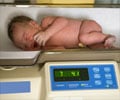Frequently Asked Questions
1. Who performs Cesarean section?The obstetricians perform the surgery. In some smaller rural hospitals a general surgeon too can perform the surgery.
2. Why do they call it a cesarean section?
The procedure is known as a cesarean section as it is thought that the Roman emperor, Julius Caesar was born through the same. Although there is no conclusive proof to evidence the theory, it is widely believed.
3. If my first child was born via Cesarean section, can I not undergo a normal delivery for my next child?
One can have a vaginal birth after Cesarean (VBAC) except for those cases where the first Cesarean was performed for conditions like small, deformed pelvis and so on. Your obstetrician will be best person to judge whether or not you can undergo a normal delivery.
4. How can I participate in my C-section?
Although the procedure does not require a mother’s involvement as much as a vaginal delivery does but you don’t need to feel left out. You may not see your baby being delivered but almost instantaneously hear its voice.
A ‘gentle’ Cesarean section is also being performed nowadays in which the baby is allowed to crawl out of the incision on its own. An increasing number of doctors now believe in early skin-to-skin contact and let the baby rest on the mother’s chest while the incision is being sutured. You may talk to your doctor about the options.
5. After a Cesarean section should I not lift heavy weights?
You can lead a normal life by the end of one month. Until then you can avoid doing heavy manual work
6. What is the best anesthesia to have for a Caesar?
Spinal and epidural are safe for the mother as well as the baby. General anesthesia is associated with more complications but may have to be the anesthesia of choice in certain maternal conditions
7. I have heard that a spinal or epidural can cause backache in the future -is this true?
A spinal or epidural cannot give rise to a backache which did not exist before.
Every woman who goes through pregnancy and childbirth, be it normal vaginal delivery, Cesarean section under general anesthesia or Caesar under spinal anesthesia is at a high risk category of developing backache due to the altered mechanics of the spine during pregnancy.
Weight gain, bearing extra weight of the fetus, alteration of the curve of the backbone during pregnancy, stretching of muscles of ligaments all contribute to the occurrence of backache following pregnancy. The backache cannot be attributed to the spinal or epidural anesthesia. It is therefore important to do post-natal exercises to strengthen the back and abdominal muscles and regain the lost tone to minimize the occurrence of backache.
8. My colleague who underwent a C-section for her baby’s delivery had to undergo a hysterectomy (uterus removal) at the same time. What is that due to?
Rarely the mother may bleed excessively during a c-section. At such times, when all measures to stop the massive blood loss have been tried and has failed, a hysterectomy or removal of the uterus is done as a last resort to save the mother from dying due to excess hemorrhage. This scenario is also fortunately very rare.
9. Immediately after a Cesarean section, will I be in position to feed my baby?
You may have pain in the post-operative period which can be taken care of by means of medications given either via the epidural catheter, or as a suppository or as injections and you will then be able to feed your baby.
10. Would I require a blood transfusion during C-section?
If you have lost a lot of blood, you may require a blood transfusion. If the bleeding is not easily controlled, you may require a transfusion of the clotting factors or platelet cells.











